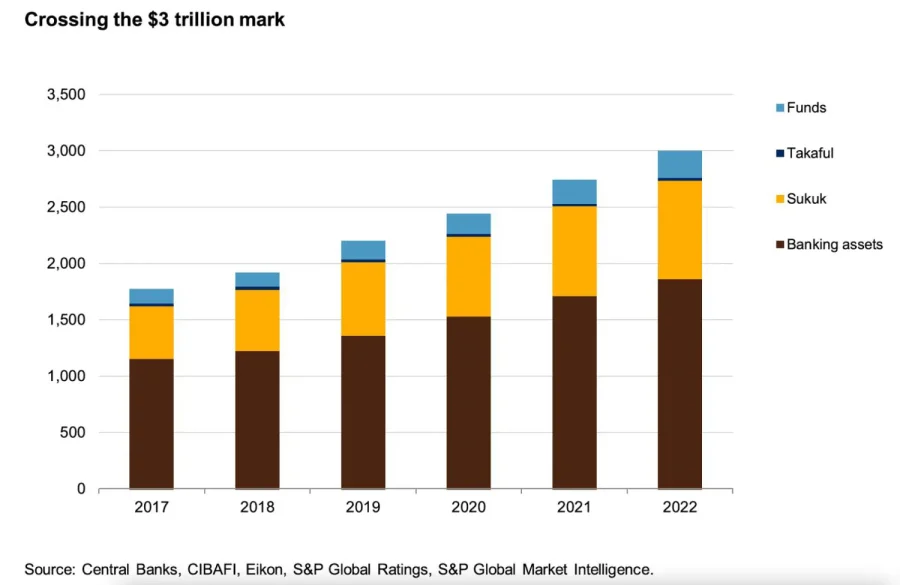Driven by favourable dynamics in the GCC and a few other core markets, the size of the global Islamic finance industry is poised to cross the $3.0 trillion mark this year, growing by around 10 per cent after expanding at a similar pace in 2022, S&P Global Ratings said.
In 2022, GCC countries drove most of the growth in banking assets. Similarly, Malaysia and GCC countries accounted for a large portion of the sukuk market during the same period.
In a report titled “Islamic Finance 2023-24: Growth beyond core market remains market remains elusive,” S&P’s primary credit analyst Mohamed Damak said while sukuk issuance will likely continue to decline in 2023, new issuances are expected to exceed maturities with sustainability-linked sukuk issuances continuing to increase, albeit from a low base.
The GCC countries — notably Saudi Arabia and Kuwait — largely fuelled this performance, supported by a large, one-off acquisition in the latter. Elsewhere, growth was either muted or held back by local currency depreciation. this was mainly due to Kuwait Finance House’s (KFH’s) acquisition of Ahli United Bank.
S&P forecasts a material slowdown in GCC economies’ real GDP growth in 2023-2024, compared with 2022, largely based on lower oil production. “However, we think that Saudi Arabia’s banking system performance will continue to underpin a large portion of the expanding Islamic finance industry. In other GCC countries, growth of about 5.0 per cent appears plausible in the absence of new major government investment cycles.”
According to the 2022 Islamic Finance Development Indicator (IFDI) released by Refinitiv, an (LSEG) London Stock Exchange Group Business, and the Islamic Corporation for the Development of the Private Sector (ICD), the global Islamic finance industry is expected to reach $5.9 trillion by 2026 driven by Islamic banks and sukuks
Malaysia led the IFDI list in 2022 with a score of 113, followed by Saudi Arabia (74), Indonesia (61), Bahrain (59), Kuwait (59), the UAE (52), Oman (48), Pakistan (43), Qatar (38) and Bangladesh (36). The GCC has the highest average score while the United States and countries in Europe have the lowest.
According to the indicator, Islamic banking currently holds 70 per cent of the global Islamic finance industry while sukuk’s grew by 14 per cent in 2021 to $713 billion.
Islamic funds, the third biggest sector, saw standout growth of 34 per cent to $238 billion worth of assets under management in 2021.
Islamic finance experts are optimistic about the continued double-digit growth of the global Islamic finance industry because of the prevailing positive developments in new and emerging markets such as in Central Asia and North Africa.
The developments in these regions especially with regards to regulations and capacity-building have been years in the making.
The big and more mature Islamic finance markets such as the six countries of the GCC, Malaysia, and Indonesia, continue to strengthen their industries and lead with developments and innovations in segments like Islamic FinTech, regulations, and sustainability.
Over the next couple of years, analysts expect progress toward greater industry standardisation — in part supported by the digitalisation of sukuk issuance could enhance Islamic finance’s structural growth potential.
At the same time, the increasing focus on sustainability-related themes by core Islamic finance players will create new opportunities for the industry. They expect the contribution of sustainability-linked sukuk to continue increasing in the next 12-24 months, albeit from a low base.
Analysts expect sukuk issuance will continue to spur the Islamic finance industry’s expansion despite slowing issuance volumes overall. While volumes are generally expected to diminish in 2023, most experts still believe that new issuance will exceed maturing sukuk, resulting in another positive contribution of the sukuk market to industry growth in 2023.—Khaleej Times










